1998 GMC SIERRA ECU
[x] Cancel search: ECUPage 183 of 452
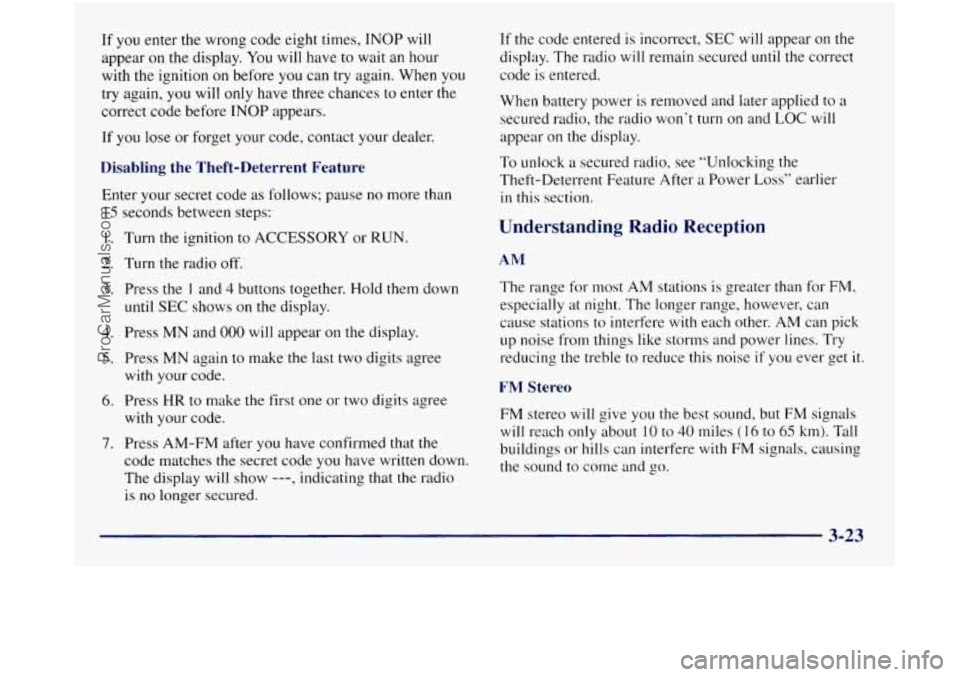
If you enter the wrong code eight times, INOP will
appear on
the display. You will have to wait an hour
with the ignition on before you can try again. When you
try again,
you will only have three chances to enter the
correct code before INOP appears.
If you lose or forget your code, contact your dealer.
Disabling the Theft-Deterrent Feature
Enter your secret code as follows; pause no more than
15 seconds between steps:
1. Turn the ignition to ACCESSORY or RUN.
2. Turn the radio off.
3. Press the 1 and 4 buttons together. Hold them down
until SEC shows on the display.
4. Press MN and 000 will appear on the display.
5. Press MN again to make the last two digits agree
with your code.
6. Press HR to make the first one or two digits agree
with your code.
1. Press AM-FM after you have confirmed that the
code matches the secret code you have written down.
The display will show
---, indicating that the radio
is no longer secured.
If the code entered is incorrect, SEC will appear on the
display. The radio
will remain secured until the correct
.code is entered.
When battery power is removed and later applied to a
secured radio, the radio won‘t turn on and
LOC will
appear
on the display.
To unlock a secured radio, see “Unlocking the
Theft-Deterrent Feature After a Power
Loss” earlier
in this section.
Understanding Radio Reception
AM
The range for most AM stations is greater than for FM,
especially at night. The longer range, however, can
cause stations to interfere with each other. AM can pick
up noise from things like storms and power lines. Try
reducing the treble to reduce this noise
if you ever get it.
FM Stereo
FM stereo will give you the best sound, but FM signals
will reach only about 10 to 40 miles (16 to 65 km). Tall
buildings or hills can interfere
with FM signals, causing
the sound to come and
go.
3-23
ProCarManuals.com
Page 202 of 452
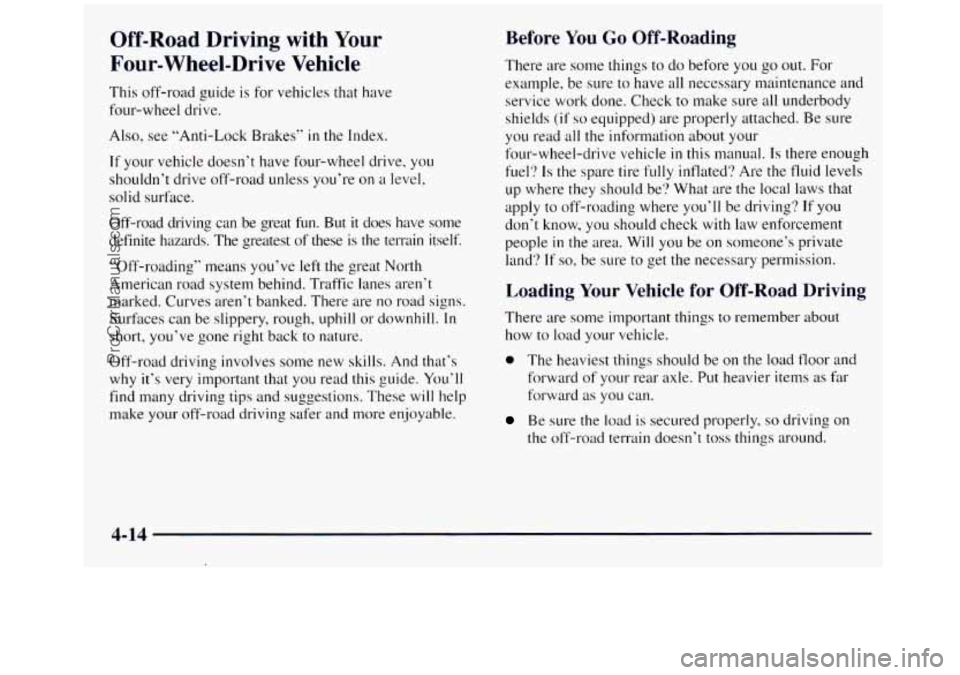
Off-Road Driving with Your
Four-Wheel-Drive
Vehicle
This off-road guide is for vehicles that have
four-wheel drive.
Also, see “Anti-Lock Brakes“
in the Index.
If your vehicle doesn’t have four-wheel drive, you
shouldn’t drive off-road unless you’re on a level,
solid surface.
Off-road driving can be great fun. But
it does have some
definite hazards. The greatest of these is the terrain itself.
“Off-roading” means you’ve left
the great North
American road system behind. Traffic lanes aren’t
marked. Curves aren’t banked. There are
no road signs.
Surfaces can be slippery, rough, uphill or downhill.
In
short, you’ve gone right back to nature.
Off-road driving involves some new skills. And that’s
why it’s very important that you read this guide. You’ll
find many driving tips and suggestions. These
will help
make your off-road driving safer and more enjoyable.
Before You Go Off-Roading
There are some things to do before you go out. For
example, be
sure to have all necessary maintenance and
service work done. Check
to make sure all underbody
shields
(if so equipped) are properly attached. Be sure
you read
all the information about your
four-wheel-drive vehicle
in this manual. Is there enough
firel‘?
Is the spare tire fully inflated? Are the fluid levels
up where
they should be‘? What are the local laws that
apply to off-roading where you’ll be driving?
If you
don’t know, you should check
with law enforcement
people
in the area. Will you be on someone’s private
land?
If so, be sure to get the necessary permission.
Loading Your Vehicle for Off-Road Driving
There are some important things to remember about
how to load your vehicle.
0 The heaviest things should be on the load floor and
forward of your rear axle. Put heavier items
as far
forward
as you can.
Be sure the load is secured properly, so driving on
the off-road terrain doesn’t toss things around.
4-14
ProCarManuals.com
Page 203 of 452
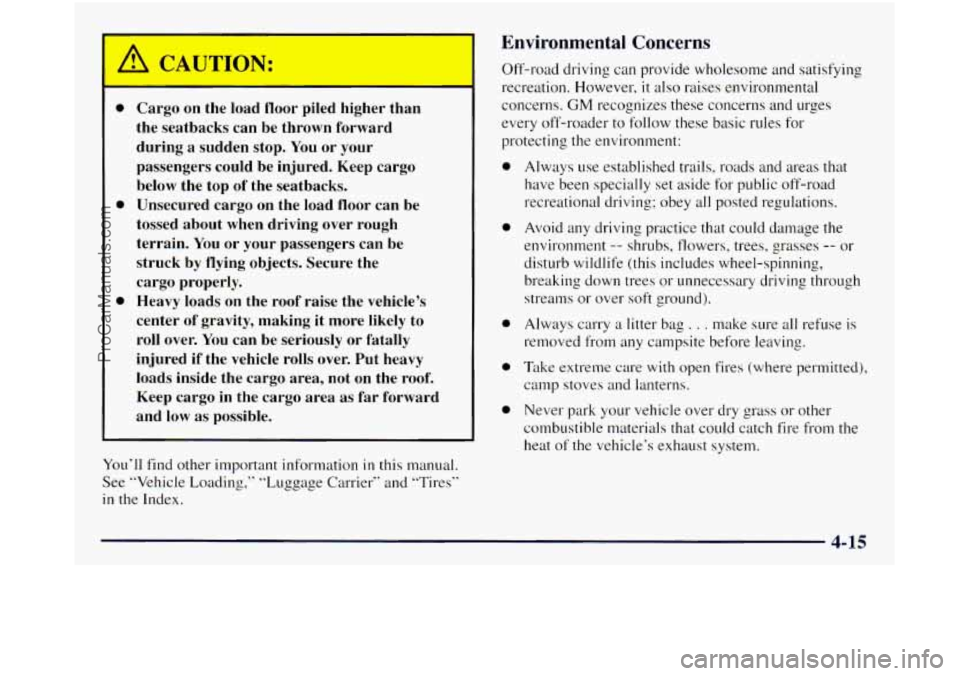
Environmental Concerns
0
0
0
Cargo on the load floor piled higher man
the seatbacks can be thrown forward during a sudden stop. You or
your
passengers could be injured. Keep cargo
below the top of the seatbacks.
Unsecured cargo on the load floor can be
tossed about when driving over rough
terrain. You or your passengers can be
struck
by flying objects. Secure the
cargo properly.
Heavy loads on the roof raise the vehicle's
center of gravity, making it more likely to
roll over. You can be seriously or fatally
injured if the vehicle rolls over. Put heavy
loads inside the cargo area, not on the roof.
Keep cargo in the cargo area as
far forward
and low as possible.
You'll find other important information in this manual.
See "Vehicle Loading," "Luggage Carrier" and "Tires"
in the Index. Off-road
driving can provide wholesome and satisfying
recreation. However,
it also raises environmental
concerns.
GM recognizes these concerns and urges
evesy off-roader to follow these basic rules for
protecting the environment:
0
0
0
e
0
Always use established trails, roads and areas that
have been specially set aside
for public off-road
recreational driving; obey all posted regulations.
Avoid any driving practice that could damage the
environment
-- shrubs, flowers, trees, grasses -- or
disturb wildlife (this includes wheel-spinning,
breaking down trees or unnecessary driving through
streams or over soft ground
j.
Always carry a litter bag . . . make sure all refuse is
removed from any campsite before leaving.
Take extreme care
with open fires (where permitted),
camp stoves and lanterns.
Never park your vehicle over dry grass or other
combustible materials that could catch fire from the
heat of the vehicle's exhaust system.
4-15
ProCarManuals.com
Page 224 of 452
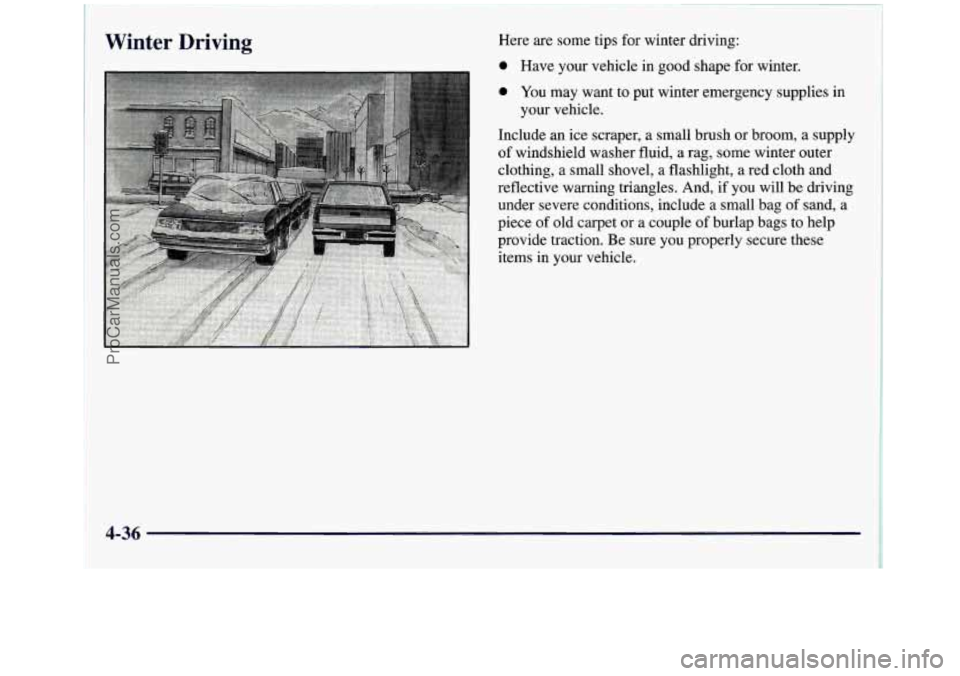
1
Winter Driving Here are some tips for winter driving:
0 Have your vehicle in good shape for winter.
0 You may want to put winter emergency supplies in
Include an ice scraper, a small brush or broom, a supply
of windshield washer fluid, a rag, some winter outer
clothing, a small shovel, a flashlight, a red cloth and
reflective warning triangles. And,
if you will be driving
under severe conditions, include a small bag
of sand, a
piece
of old carpet or a couple of burlap bags to help
provide traction. Be sure you properly secure these
items
in your vehicle.
your vehicle.
4-36
ProCarManuals.com
Page 230 of 452
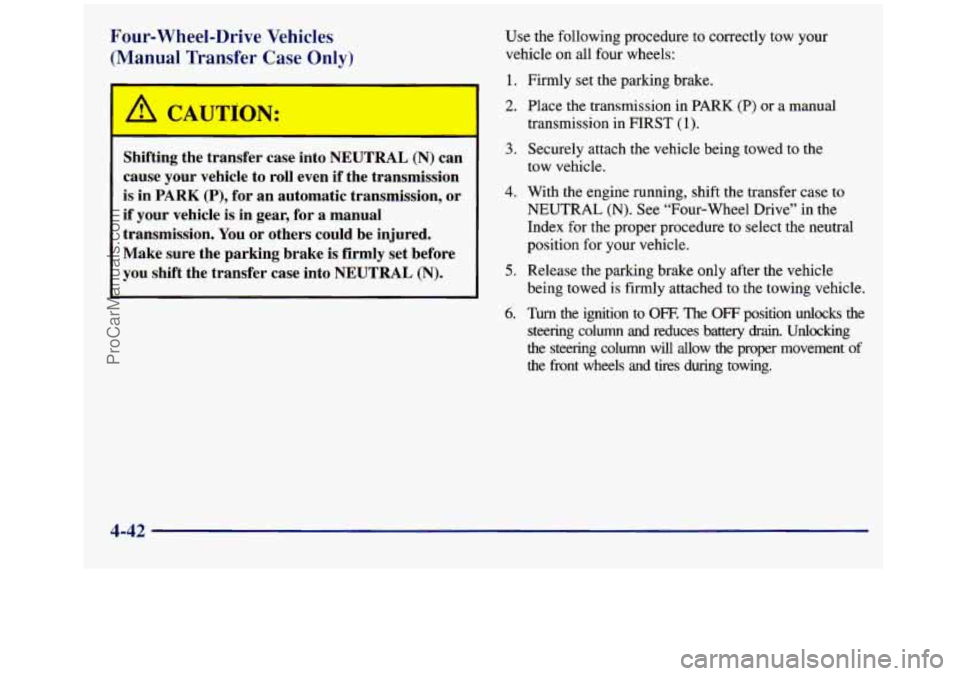
Four-Wheel-Drive Vehicles
(Manual Transfer Case Only)
‘A
-
Shifting the transfer case into NEUTRAL (N) can
cause your vehicle to roll even if the transmission
is in
PARK (P), for an automatic transmission, or
if your vehicle is in gear, for
a manual
transmission.
You or others could be injured.
Make sure the parking brake is firmly set before
you shift the transfer case into NEUTRAL (N).
Use the following procedure to correctly tow your
vehicle on all four wheels:
1.
2.
3.
4.
5.
6.
Firmly set the parking brake.
Place the transmission in
PARK (P) or a manual
transmission in FIRST
(1).
Securely attach the vehicle being towed to the
tow vehicle.
With the engine running, shift the transfer case to
NEUTRAL
(N). See “Four-wheel Drive” in the
Index for the proper procedure to select the neutral
position for your vehicle.
Release the parking brake only after the vehicle
being towed is firmly attached to the towing vehicle.
Turn the ignition to
OFF, The OFF position unlocks the
steering column and reduces battery
drain. Unlocking
the steering column will allow the proper movement
of
the front wheels and tires during towing.
4-42
ProCarManuals.com
Page 231 of 452

Loading Your Vehicle
~EE ~NER'S MANUAL FOR ADDITIONAL INFORMATION. TI
The CertificatiodTire label is found on the rear edge of
the driver's door or in the Incomplete Vehicle Document
in the cab.
The label shows the size of your original tires and the
inflation pressures needed to obtain the gross weight
capacity
of your vehicle. This is called the Gross Vehicle
Weight Rating (GVWR). The GVWR includes the
weight
of the vehicle, all occupants, fuel and cargo.
The CertificatiodTire label also tells you the maximum
weights for the front and rear axles, called Gross Axle
Weight Rating (GAWR).
To find out the actual loads on
your front and rear axles, you need to
go to a weigh
station and weigh your vehicle. Your dealer can help
you with this. Be sure to spread out your load equally on
both sides
of the centerline.
Never exceed the GVWR
for your vehicle, or the
GAWR for either the front or rear axle.
And,
if you do have a heavy load, you should spread
it out.
A CAUTION:
In the case of a sudden stop or collision, things
carried in the bed of your truck could shift
forward and come into the passenger area,
injuring
you and others. If you put things in the
bed of your truck, you should make sure they are
properly secured.
4-43
ProCarManuals.com
Page 232 of 452
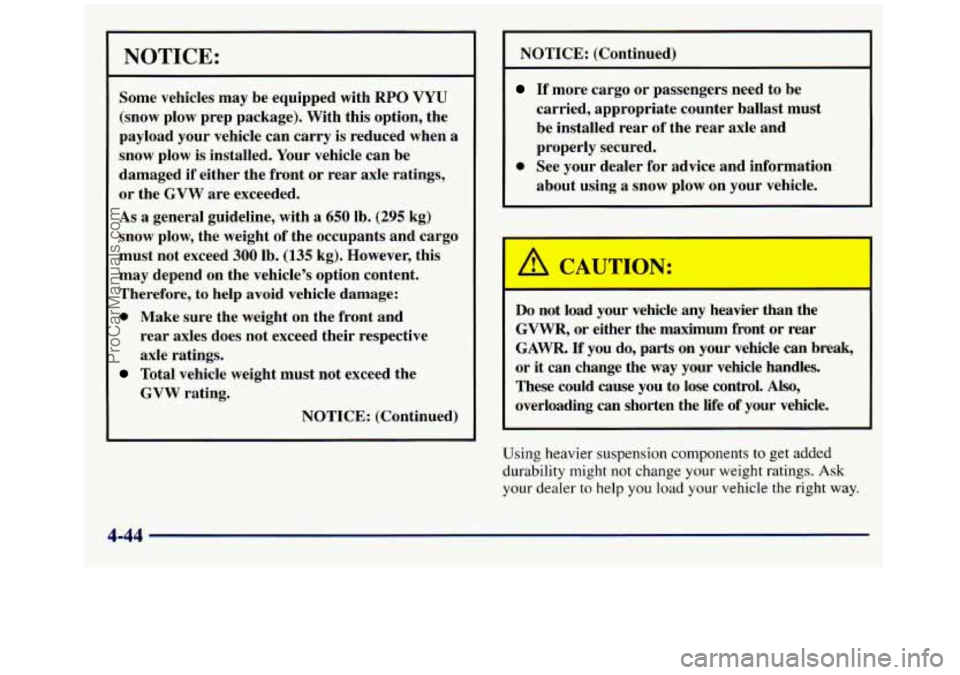
NOTICE:
Some vehicles may be equipped with RPO VYU
(snow plow prep package). With this option, the
payload your vehicle can carry is reduced when
a
snow plow is installed. Your vehicle can be
damaged if either the front or rear axle ratings,
or the GVW are exceeded.
As a general guideline, with a 650 Ib. (295 kg)
snow plow, the weight of the occupants and cargo
must not exceed
300 lb. (135 kg). However, this
may depend on the vehicle's option content.
Therefore, to help avoid vehicle damage:
0 Make sure the weight on the front and
rear axles does not exceed their respective
axle ratings.
GVW rating.
Total vehicle weight must not exceed the
NOTICE: (Continued)
I NOTICE: (Continued) I
If more cargo or passengers need to be
carried, appropriate counter ballast must
be installed rear of the rear axle and
properly secured.
0 See your dealer for advice and information
about using
a snow plow on your vehicle.
Do not load your vehicle any heavier than the
GVWR, or either the maximum front or rear
GAWR.
If' you do, parts on your vehicle can break,
or it can change the
way your vehicle handles.
These could cause you to lose control.
Also,
overloading can shorten the life of your vehicle.
Using heavier suspension components to get added
durability might not change your weight ratings.
Ask
your dealer to help you load your vehicle the right way.
4-44
ProCarManuals.com
Page 233 of 452
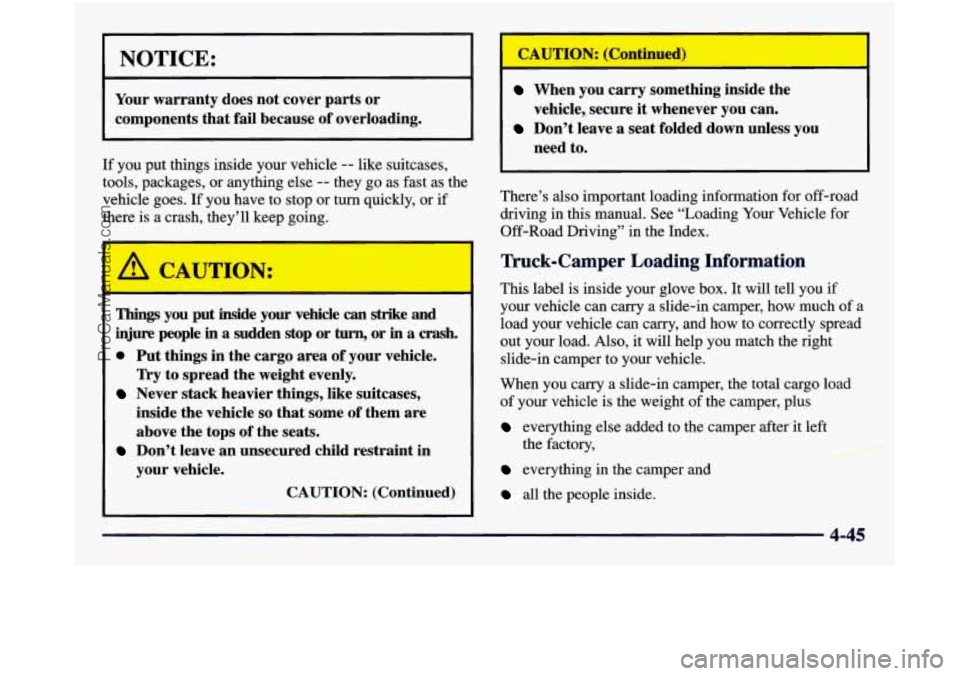
c
NOTICE:
Your warranty does not cover parts or
components that fail because of overloading.
If you put things inside your vehicle -- like suitcases,
tools, packages, or anything else
-- they go as fast as the
vehicle goes.
If you have to stop or turn quickly, or if
there is a crash, they’ll keep going.
Things you put inside your vehicle can strike and
injure people in a sudden stop or turn, or in a crash.
0 Put things in the cargo area of your vehicle.
Try to spread the weight evenly.
Never stack heavier things, like suitcases,
inside the vehicle
so that some of them are
above the tops
of the seats.
Don’t leave an unsecured child restraint in
your vehicle.
CAUTION: (Continued)
When you carry something inside the
vehicle, secure it whenever you can.
Don’t leave a seat folded down unless you
need to.
There’s also important loading information for off-road
driving in this manual. See “Loading Your Vehicle for
Off-Road Driving” in the Index.
Truck-Camper Loading Information
This label is inside your glove box. It will tell you if
your vehicle can carry a slide-in camper, how much
of a
load your vehicle can carry, and how to correctly spread
out your load. Also, it will help you match the right
slide-in camper to your vehicle.
When you carry a slide-in camper, the total cargo load
of your vehicle is the weight of the camper, plus
everything else added to the camper after it left
the factory,
everything in the camper and
all the people inside.
4-45
ProCarManuals.com